
Guests
- Raha Bahreinihuman rights lawyer and researcher on Iran for Amnesty International.
- Reza AslanIranian American scholar, producer and author.
Anti-government protests in Iran, first sparked last month by the death of 22-year-old Mahsa Amini, have moved into their fourth week. The youth and women-led protests cross class and ethnic divides, and the demands have grown in scale and scope, with many, even in the clerical community, now calling for the complete abolition of the Islamic Republic. Many sectors of society, including businesses and unions, have also joined in protest, with oil workers from one of the country’s major refineries going on strike Monday. Iranian authorities have launched a violent assault on protesters in response, explains Amnesty International’s Raha Bahreini, with security forces shooting live ammunition into crowds to disperse the protests, leaving thousands injured and at least 144 victims dead, 24 of them children. The government violence is “indicative of just what a threat the regime believes these protests are,” argues Iranian American scholar Reza Aslan, who says that despite numerous revolutions in Iran’s history, “this time feels different.”
Transcript
AMY GOODMAN: We begin today’s show in Iran, where anti-government protests are in their fourth week, sparked last month by the death of 22-year-old Mahsa Amini while in custody of Iran’s so-called morality police. On Monday, oil workers went on strike in support of the protests. Meanwhile, the death of 16-year-old Nika Shakarami has ignited more public rage. The girl’s family says she disappeared after being chased by security forces for burning her headscarf during a protest, and was found 10 days later in a morgue. Human rights groups say more than 200 people have been killed in the deadly crackdown on protests, including an estimated 23 children, with hundreds more injured and thousands arrested.
Iran’s Supreme Leader Ayatollah Ali Khamenei condemned the widening protests in an address Wednesday.
AYATOLLAH ALI KHAMENEI: [translated] Some are either agents of the enemy, or if they aren’t agents of the enemy, then they are aligned with the enemy. With the same goals, they take to the streets. Others are just excited. The second group can be fixed with cultural works. The first group must be dealt with by judicial and national security officials. Some say the atmosphere should not become one of national security, and we agree, to where it’s possible. The atmosphere in the country should not become one of national security, but the cultural programs should be differentiated from the judicial and security matters.
AMY GOODMAN: This comes as the chief of Iran’s judiciary has now ordered judges to issue harsh sentences for what he called the, quote, “main elements of riots.” Iran’s education minister, Yousef Nouri, said in an interview Tuesday some teenage student protesters are being detained and taken to what he called “psychological institutions,” saying they, quote, “can return to class after they’ve been reformed,” unquote.
One of the many teenagers reportedly killed by Iranian security forces was 15-year-old Siavash Mahmoudi. This is his mother calling for justice in the streets of Tehran.
SIAVASH MAHMOUDI’S MOTHER: [translated] This is my Siavash, my son. I will have a funeral for him in Aliabad, in Saheb-e-Zaman mosque. Siavash was a boy from Shahrak-e Beheshti neighborhood. We have lived here for several years. I was a single mom and raised this kid alone. They have killed my son so unfairly and cowardly at the end of this street. They shot him in the head. This is Iran’s Siavash! This is Iran’s Siavash!
AMY GOODMAN: For more, we’re joined by two guests. Joining us in London is Raha Bahreini, a human rights lawyer who is Amnesty International’s Iran researcher. And in Washington, D.C., Reza Aslan is with us, scholar, producer, author. His recent piece for Time is headlined “The Iranian People’s 100-Year Struggle for Freedom.” His new book is titled An American Martyr in Persia: The Epic Life and Tragic Death of Howard Baskerville.
We welcome you both to Democracy Now! Raha Bahreini, let’s begin with you. Can you talk about the broadening scope of the protests and the Iran government’s crackdown on them? What have you documented at Amnesty International?
RAHA BAHREINI: Hello, Amy. Thank you for having me.
The Iranian authorities have shown a deadly resolve to crush the spirit of resistance among Iran’s youthful population and to retain their iron grip on power. Amnesty International has documented widespread, unwarranted use of firearms and lethal force by Iran’s security forces. The Iranian security forces have been firing live ammunition simply to disperse crowds and to crush the protests. The deadly crackdown has so far left over 144 victims that we have identified by name; among them are at least 24 children. Their names and details of their deaths have been documented by Amnesty International in a report that we are issuing today. Among the children are three girls who were beaten to death. In addition, the vast majority of the boys were shot by live ammunition in their head, chest or upper body. The vast majority of those killed have been killed due to security forces firing live ammunition at their head or chest, which shows the intention of the security forces to kill protesters, or their knowledge that their firing of live ammunition would result in death, and they nevertheless proceeded with these deadly activities in order to crush the protests. We have also documented widespread patterns of torture and other ill treatment, including severe beatings of protesters and bystanders in the streets at the hands of security forces.
Amnesty International obtained some leaked documents from the national headquarters of Armed Forces, which is the highest military body in Iran. And on the 21st of September, they ordered armed commanders in all provinces across Iran to crush the protesters severely and mercilessly. And since then, we documented an escalated use of lethal force, an escalation in the use of lethal force by the Iranian security forces. And just on the night of 21st of September alone, dozens of men, women and children were killed. The next deadliest day was the 30th of September in Zahedan, Sistan, Balochistan province, which is populated by Iran’s oppressed Balochi minority. The security forces opened fire on protesters and bystanders, and in the course of several hours they killed over 85 men, women and children.
NERMEEN SHAIKH: Reza Aslan, if you could talk about, respond to the scale of these protests, and them, the protests, continuing despite the Iranian regime’s increasingly brutal crackdown on the protesters, and the fact, we just heard in our introduction, that Ayatollah Ali Khamenei has dismissed many of the protesters as, quote, “agents of the enemy”?
REZA ASLAN: [inaudible] de rigueur. Any time there’s any kind of instability in the country or protest against his regime, he’s always going to lash out at the United States and Israel, and place blame on outsiders for what is, in effect, the failures of his own leadership and the regime itself. But I think what’s important to understand is that the scale of this backlash from the government, the horrific violence that we just heard, is indicative of just what a threat the regime believes these protests are, because, as you rightly note, they are not diminishing. In fact, they are expanding.
And they’re not just expanding in scope and scale and size; much more importantly, they’re expanding in terms of a broader coalition. You mentioned that now business interests, merchants, unions are going on strike. We have ethnic minorities, not just in Balochistan, but also the Kurdish areas of Iran, that are clamoring for independence. And in a very surprising move, actually, we’re even seeing regime supporters, ostensible regime supporters, more sort of of the pious masses, in cities like Qom, which is, of course, the religious capital of Iran — we’re seeing widespread protests there, and not just protests against the morality police or in response to the death of Mahsa Amini and so many other young children, but protests very brazenly calling for the downfall of Ayatollah Khamenei, being chanted in what is essentially Khomeini — Khamenei’s backyard — pardon me — in Qom. And so, I think what’s happening now is that this coalition of Iranians on the street is becoming a serious threat to the very existence of the Islamic Republic. And unfortunately, as a result, I think we’re going to see an even bloodier response from the military and from the regime in the coming weeks.
NERMEEN SHAIKH: And, Reza, can you talk about the demographics, the groups of people who are not participating? You pointed out in a recent piece that younger clergy, as well as seminary students, have not yet joined, but if they do, you think that would lead to a substantial change. Explain.
REZA ASLAN: Well, I think most outsiders don’t understand how unpopular the Islamic Republic, the theological underpinning of clerical rule in Iran, is amongst the sort of rank-and-file Shia clergy. This is not the majority view, the so-called Valayat-e Faqih, which is the theological underpinning that allows for clerics, clergy in Iran, to have direct political control over the country. There is no theological history behind this idea. On the contrary, it actually violates 14 centuries of Shia quietism when it comes to political influence over government. But what Ayatollah Khomeini, the founder of the Islamic Republic, did in coming up with this idea was essentially create a whole new way of thinking about what Shiism is as a religion.
And while it is true that amongst the upper echelon of the clergy, the ayatollahs, certainly those in government positions, this theory has become entrenched, the truth of the matter is that in the seminaries in Iran, and especially in Qom, younger seminarians, mid-level clerics, the sort of what we would refer to as kind of local imams are not just debating the very legitimacy of clerical rule but are now, seemingly, coming out and rejecting it more and more vocally. And my argument was, when you start seeing that kind of start to roll out and younger seminary students, mid-level clerics begin to speak out against the very legitimacy of the theocracy of the state, well, that might be pretty much all she wrote when it comes to the clerical regime.
AMY GOODMAN: Raha Bahreini, I want to specifically focus on these women-led protests and the children. You have a report that was embargoed until today on the deaths of the children. And we just reported on the education minister saying they’re taking some children and they’re putting them in institutions to reeducate them? Can you talk about what you have found? And also, this issue of Balochistan, for people around the world who may not be familiar with the geography of Iran, the significance of the killings of more than 80 people there?
RAHA BAHREINI: The Iranian authorities have waged an all-out assault on children who have courageously taken to the streets in order to demand a future without political oppression and injustice. As your other guest just explained, these protests are very youthful in nature. And schoolchildren and young university students have been visibly present in protests calling for an end to the Islamic Republic system and for Iran’s transition to a political system that respects their fundamental rights and freedoms.
In response, the Iranian authorities have used horrific forms of force, including live ammunition, in order to kill these children or otherwise harm and injure them. We have documented the names of 24 children. Four of them were beaten to death. Two of them died after they were shot with metal pellets at close range. And the rest were shot with live ammunition, often in their head, chest or upper body. The Iranian authorities have the blood of children on their hands.
And the more distressing pattern is that instead of conducting any investigations, they are, in fact, now harassing and intimidating the families of these children in order to coerce them into making video recorded statements and accept the authorities’ bogus narrative that the children committed suicide or died during car accidents. This is not the first time that the Iranian authorities try to cover up the crimes that they commit, including against children in the context of protests. During the nationwide protests of 2019, the Iranian authorities also unlawfully killed hundreds of men and women, including 21 children.
The fact that they have been able to continue these successive waves of protest bloodshed is because of a deep crisis of systemic impunity that has long prevailed in Iran. And the price of this impunity is being paid by the lives of people in the streets in Iran. And this is because there is no independent judiciary in Iran to conduct investigations. And the scale and gravity of the crimes committed has not received the attention and the critical, meaningful action that it should receive at the international level from member states of the U.N. Human Rights Council.
The events in Balochistan last Friday, on the 30th of September, showed the scale of the crackdown and is an extreme manifestation of the deadly crackdown that the Iranian authorities have long waged on Iran’s oppressed minorities. We have documented extensive use of lethal force and high numbers of death in Balochistan, which is populated by Iran’s oppressed Balochi minority, and in Kurdistan and Kermanshah and West Azerbaijan provinces, that are populated by Iran’s oppressed Kurdish minority. As you may know, the protests actually started in Kurdish-populated cities, because Mahsa was of Kurdish origin.
And now there is solidarity among Iranians all over the country. And this is the inspiring aspect of the protests, that it crosses across ethnic groups and class divides, and has encompassed demands for a transition to a different political system. And in this relation, many protesters and commentators in Iran consider these protests as a nationwide uprising against the aging theocratic system that has long engaged in systematic human rights violations and granted absolute impunity to those who kill, torture and harm people in the street, in the context of protests, and behind prison walls.
NERMEEN SHAIKH: Reza, let’s look at this protest in historical context. You’ve written that of the three major revolutions over the course of the last century in Iran, the 1906 Constitutional Revolution provides the best historical analogy to the present uprising. In recent L.A. Times piece, you write, quote, “The Persian Constitutional Revolution may not have transformed Iran into a real democracy. But it set the precedent for the exercise of people power in Iran, creating one of the most robust protest cultures in the world.” Talk about that.
REZA ASLAN: Yeah, the 1906 Constitutional Revolution was not just the first of Iran’s three major revolutions of the 20th century, but it was the first democratic revolution in the Middle East. And while it had a very simple goal, which was the creation of a constitution that would outline the rights and privileges of all citizens and the creation of an elected parliament that would serve to check the absolute authority of the shah of Iran, and while it did achieve that goal for a very, very brief while, until autocracy was returned to Iran with the ascendance of Reza Khan, or Reza Shah Pahlavi, and the Pahlavi regime, which itself suffered two more revolutions — one in ’53 and one in 1979 — I think what it reminds us is that the women and men and, frankly, children who are on the streets right now dying for their most basic rights, the rights to have a voice, to have a say in the decisions that rule their lives, to be able to say and think what they wish — again, the most basic of human rights — that this struggle has been going on not for a couple of weeks, not for a couple of months, but for more than a century in Iran, against successive governments, be they the shahs or now the Islamic Republic.
But I think that this time — I have to be honest with you — having studied history, having lived through the 1979 revolution, this time feels different. There is a fearlessness that we are seeing on the streets, particularly by young women, by teenage women, who simply have had enough and are not willing to do what successive — or, previous generations, who had also protested, who had also risen up against the regime, have been willing to do, which is accept a bit more freedom, accept a little bit of more sort of space, maybe in the private realm, in exchange for getting off the streets. What we are hearing right now, despite the fact that it is a very diverse coalition of old and young, religious and secular — we have women in chadors marching next to women wearing jeans and no veils. Despite that, there is a unified call here for not reform, but for the downfall of the regime. The regime has failed its children. And that, not just in a human way, but deeply in a Persian cultural way, is about the most shameful act that you can possibly imagine, which is why this message is working. The message of “shame, shame, shame” is working.
What we haven’t seen yet, however, is the international community actually shaming the Iranian government. I’m very glad to hear that the United Nations had a vote condemning Russia’s illegal annexation of parts of Ukraine. I am waiting for the United Nations’ vote condemning a murderous regime for kidnapping children and taking them to what they themselves refer to as psychological camps for reeducation. There is no place in the modern world for such actions. And while the United States, unfortunately, can’t do much about it — we have already blanket sanctioned Iran for four decades, there’s really very little influence that we have — the United Nations still has major influence in Iran, especially at a time in which that government’s economy is on the verge of collapse. It’s time to hear the voice of the international community as loud as possible to condemn these inhumane actions by the Islamic Republic.
AMY GOODMAN: Reza Aslan, the supreme leader of Iran, Ali Khamenei, is very old. He has cancer, grooming his son to be the next leader. Can you talk about what that means? And have you seen any defection in the military at this point, and among the police?
REZA ASLAN: Well, we have seen anecdotal evidence and videos of security personnel who have joined the protesters. We haven’t yet to see any hint of cracks in the military hierarchy, thought that does not mean that that’s not happening. The military, the Revolutionary Guard in Iran is extraordinarily powerful. In fact, many Iran watchers will tell you that the Revolutionary Guard is the real power in Iran, that the ayatollahs are basically the forward face of the government, but the levers of control are in the hands of the Revolutionary Guard. And that may very well be true. So we’re all waiting to see how the Revolutionary Guard and the military is going to respond to these unceasing demands on the street.
But the real spark that I think Iran watchers are waiting for is: What happens if these protests continue, and this is a long, long marathon of a revolution, and in the midst of this, the supreme leader, Ayatollah Khamenei, who, as you rightly note, is very sick and very old, dies? Because the succession to the third supreme leader was always going to be problematic. Again, this is not a very popular idea amongst the Shia clergy. And the notion that Khamenei, who, by all reports coming out of Iran, has been grooming his son Mojtaba, who is a mid-level cleric who has no real religious credentials to take on such a role but is nevertheless being groomed to succeed his father, is going to basically put the last nail in the coffin of any kind of legitimacy for clerical rule. Basically, at this point, the supreme leadership has become just another word for shah. It’s just another kind of monarchy. And so, I think, even at that point, die-hard regime supporters are going to start thinking twice.
We’re all waiting to see what the next spark is going to be. The spark of the death of Mahsa Amini really turned the protests that were already taking place in Iran over the last six months, over deteriorating economic conditions, into a nationwide revolution. If Khamenei were to die, if there were to some conversation about succession, that, I think, might really create a whole new level of revolution here. Already on the streets, by the way, I should mention, amongst many, many chants that we are hearing these protesters chant on the streets of Iran, a common chant is “Mojtaba, Mojtaba, we will die before we see you as the leader.”
AMY GOODMAN: Reza Aslan, we want to thank you for being with us, author of the new book, An American Martyr in Persia: The Epic Life and Tragic Death of Howard Baskerville. We’ll link to your article in Time, “The Iranian People’s 100-Year Struggle for Freedom.” And Raha Bahreini, Amnesty International’s Iran researcher, human rights lawyers, speaking to us from London.
Next up, as the U.N. General Assembly votes 143 to 5 to condemn Russia’s annexation of four territories seized from Ukraine, we’ll speak with a Ukrainian activist, a member of the European Network of Solidarity with Ukraine, and a Russian activist living in exile in Berlin. Stay with us.
[break]
AMY GOODMAN: “Baraye,” “Because Of,” by the Iranian singer Shervin Hajipour. It’s become the unofficial anthem of the Iran protests. The song’s lyrics are taken entirely from messages Iranians have posted online about why they’re protesting. “Baraye” has received more than 80% of the submissions for the Grammy Award which honors a song dedicated to social change.


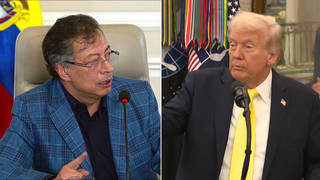
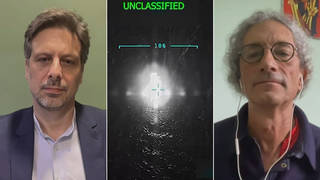
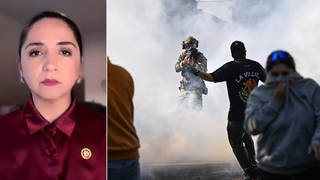





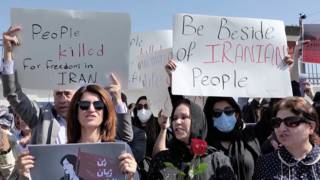
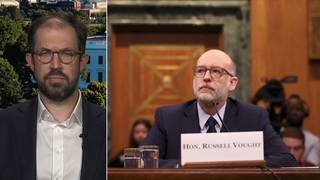
Media Options